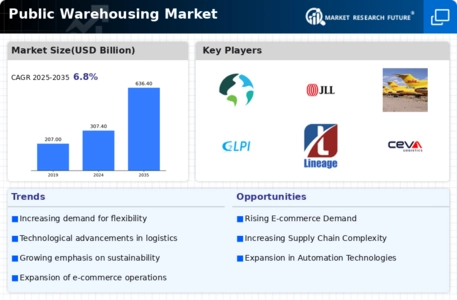Rising E-commerce Demand
The surge in e-commerce activities globally is a primary driver of the Global Public Warehousing Market Industry. As consumers increasingly prefer online shopping, the need for efficient storage and distribution solutions intensifies. Public warehouses serve as essential hubs for e-commerce businesses, facilitating quick order fulfillment and inventory management. In 2024, the market is projected to reach 307.4 USD Billion, reflecting the growing reliance on public warehousing to support logistics operations. This trend is expected to continue, with the market potentially expanding to 636.4 USD Billion by 2035, indicating a robust growth trajectory fueled by e-commerce.
Sustainability Initiatives
Sustainability initiatives are becoming increasingly important within the Global Public Warehousing Market Industry. Companies are under pressure to adopt environmentally friendly practices, and public warehouses are responding by implementing green technologies and energy-efficient solutions. This shift not only reduces the carbon footprint of warehousing operations but also appeals to environmentally conscious consumers. As sustainability becomes a core business strategy, public warehousing providers that prioritize eco-friendly practices may gain a competitive edge. This trend is expected to influence market dynamics, as businesses align their logistics strategies with sustainability goals.
Technological Advancements
Technological innovations play a crucial role in shaping the Global Public Warehousing Market Industry. Automation, artificial intelligence, and advanced inventory management systems enhance operational efficiency and accuracy in warehousing. These technologies enable real-time tracking of inventory, optimizing space utilization and reducing operational costs. As companies adopt these advancements, public warehouses become more attractive for businesses seeking to streamline their supply chains. The integration of technology is likely to contribute to a compound annual growth rate of 6.84% from 2025 to 2035, underscoring the significance of tech-driven solutions in the warehousing sector.
Global Supply Chain Resilience
The increasing focus on supply chain resilience is a notable driver of the Global Public Warehousing Market Industry. Companies are reevaluating their supply chain strategies to mitigate risks associated with disruptions. Public warehouses provide flexibility and scalability, allowing businesses to adapt to changing market conditions. By utilizing public warehousing, companies can maintain adequate inventory levels and ensure timely deliveries, thereby enhancing customer satisfaction. This shift towards resilient supply chains is expected to bolster the market, as organizations prioritize partnerships with public warehousing providers to navigate uncertainties in global trade.
Urbanization and Population Growth
Urbanization and population growth significantly influence the Global Public Warehousing Market Industry. As urban areas expand, the demand for efficient logistics and warehousing solutions increases. Public warehouses located near urban centers enable businesses to meet the rising consumer demand for quick deliveries. This trend is particularly evident in densely populated regions where space is limited, making public warehousing an attractive option for companies looking to optimize their distribution networks. The ongoing urbanization is likely to drive the market further, as businesses seek to establish a presence in key metropolitan areas.





















Leave a Comment